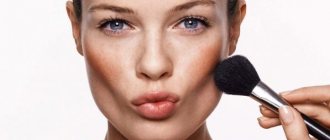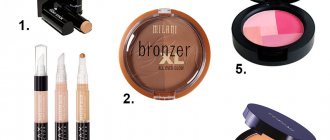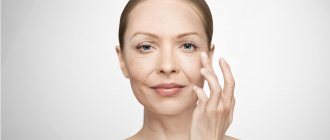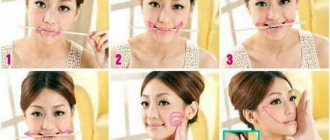Methods for increasing the volume of cheekbones Contraindications Preparation for surgery How malarplasty is performed Rehabilitation Techniques for reducing cheekbones
High, clearly defined cheekbones are one of the brightest signs of beauty, youth and good heredity. In addition, the zygomatic frame keeps the facial tissues taut - nasolabial folds are reduced, the nasolacrimal groove is smoothed, and the corners of the lips are raised. If you didn’t get perfect cheekbones from nature, you can contact a plastic surgeon to correct this area. With the advent of high-quality endoprostheses and the expansion of contouring possibilities, changing the shape of the chin or cheekbones has become not only effective, but also as safe as possible. The operation is performed for congenital or acquired (for example, as a result of an accident) defects of the maxillofacial skeleton and can eliminate the following disadvantages:
- weakly defined cheekbones;
- sagging face oval;
- sunken or too pronounced cheeks;
- deep nasolabial and nasolacrimal folds;
- facial asymmetry.
Possibilities for increasing the volume of the cheekbones
Cheek plastic surgery with implants
Correction of the shape of the cheekbones can be carried out using solid cheekbone prostheses made of porous biocompatible polyethylene or silicone implants. Endoprostheses are installed for life; they do not dissolve or become deformed. During the period of bio-integration, polyethylene implants are filled with the patient’s tissues, the structure is fixed with micro-screws, eliminating the risk of displacement. Silicone implants are more flexible and come in different shapes and sizes. All modern endoprostheses are safe, do not cause allergic reactions or rejection, are installed under the muscle and look as natural as your own cheekbones.
Endoprostheses are selected at the stage of planning the operation. Computer technology helps with this, allowing you to “try on” different types of prostheses. Implants are divided into three groups:
- to increase the width of the face;
- to increase volume and expressiveness;
- combined, solving individual problems, including complex ones.
The shape of cheekbone implants can be oval, elliptical, or anatomical. The latter are more suitable for severe deficiency of the zygomatic bone. Oval ones are most often used to correct the front part of the cheekbones.
Cheek contour contouring
When correcting cheekbones with fillers, preparations based on hyaluronic acid are injected under the skin. Due to this, the volume of the cheeks increases, the skin is moisturized and rejuvenated, and wrinkles are smoothed out. The procedure is carried out by a cosmetologist who carefully studies the contour of the face. The disadvantage of the procedure is the fragility of the result. Hyaluronic filler dissolves over time. Contour plastic surgery needs to be repeated approximately once a year.
Lipofilling of cheekbones
The volume in the right places is replenished with injections of the patient’s pre-treated own fat. The result can last for life, there is no rejection or allergies. Read more about lipofilling of cheeks and cheekbones
Rehabilitation
Features, natural temporary ailments and the duration of the rehabilitation period depend on the technique used.
Do you want your rehabilitation to go smoothly? Then I urge you to be as honest as possible with your surgeon: talk about any ailments if you have them, do not hesitate to ask questions, and conscientiously follow all recommendations.
Anesthesia
Endoprosthetics of cheekbones, removal of Bisha's lumps, check-lifting are performed under general anesthesia. Cheekbone contouring and lipofilling can be performed under general or local anesthesia.
Rehabilitation time
After check-lifting and endoprosthetics, rehabilitation lasts several months. Final recovery is approximately 7-12 months. After removing Bisha's lumps, recovery takes a little less time. After lipofilling and cheekbone contouring, rehabilitation lasts on average 3-4 months.
General rehabilitation recommendations for patients
- You cannot play sports in the first months of rehabilitation.
- Any physical activity should be avoided.
- Don't drink alcohol and give up cigarettes.
- Sleeping on your stomach is not allowed until recovery is complete.
- If the manipulations were carried out through incisions in the oral cavity, I will recommend special rinses.
- Do not steam the skin. Solarium, bathhouse, sauna, hot bath are contraindicated during rehabilitation!
- Do not temporarily apply cosmetics to your face.
- Try not to touch the incision area.
- Do not take medications without my consent.
Contraindications
Surgical correction of the cheekbones should not be resorted to until the formation of bone tissue is completed (up to 25 years), except in cases where surgery is necessary due to a congenital deformity or after an injury. Other contraindications include:
- serious diseases, including chronic ones (oncology, diabetes mellitus, serious damage to internal organs);
- blood clotting disorder;
- period of pregnancy and lactation;
- infections and inflammations (especially in the mouth).
What implants are used
The peculiarity of implants for zygomatic implantation is their length. It should be sufficient to be located along the cheekbone or along the pterygoid process and exit at the alveolar ridge.
The creation of the zig by Nobel Biocare marked the beginning of the production of similar models from other manufacturers. The length of all products is 2-3 times longer than traditional implants and reaches up to 60 mm; for Zygoma it is 52.5 mm. The edge of the pin can be straight or beveled. Implants can be single-piece, which do not require an abutment, or two-piece, which require one. Installing zygomatic implants requires great professionalism. The doctor must be not just an implantologist, but also a specialist in facial surgery.
An alternative to zigs are pterygoids.
Operation
Correction of the profile of the zygomatic protrusion with implants is performed through internal or external access. In the first case, an incision is made on the mucous membrane from the side of the oral cavity, its length is up to 1 cm. This access is more aesthetic because there are no external scars left. But it carries a greater risk of infectious complications. Before the operation, you will definitely need to visit the dentist and sanitize the oral cavity. With external access or when combined, for example, with a check-lift, an incision is made in the temple area along the hairline or in a natural fold of the skin, so the scar is almost invisible. Its advantage is also that, together with malarplasty, a lift can be done at the same time. After access is established, a “pocket” is made into which the implant is placed on the cheekbone. It is secured with two sutures and surrounding soft tissue.
Prosthetics on zygomatic implants –
Prosthetics with a completely fixed bridge will begin immediately after installation of the implants and, thus, you will receive your prosthesis within 2-3 days after surgery. The important point is that at first you will only receive a temporary fixed prosthesis, which is also called an adaptation prosthesis. You can use such a temporary prosthesis for an average of 2 years (maximum up to 3 years) - after which it will need to be replaced with a permanent one.
Price of zygomatic implantation in Moscow –
- All-on-4 technique on “Nobel Biocare” implants (2 of them will be “Nobel-Zygoma” zygomatic implants and 2 more classic “Nobel-Speedy Groovy” implants) - together with an adaptive prosthesis on a metal frame will cost you about 500,000 rubles .
- All-on-6 technique on “Nobel Biocare” implants (2 of them will be “Nobel-Zygoma” zygomatic implants and 4 more classic “Nobel-Speedy Groovy” implants) - together with an adaptive prosthesis on a metal frame will cost you about 600,000 rubles .
Zygomatic implantation (All-on-4 technique) –
As we said above, permanent prosthetics are carried out over a period of 2 to 3 years, and the patient is offered a huge selection of options for permanent fixed prostheses. This can be an acrylic or ceramic composite fixed prosthesis on a titanium frame, or bridges made of metal ceramics and zirconium dioxide, as well as other options. You can read more about the options and cost of the permanent prosthetics stage in the article at the link below:
→ Prosthetic options for All-on-4 and All-on-6
Recovery
The bandage is removed after two days, and the incisions usually take less than a week to heal. To speed up the process, rinses are used (if the dentures were inserted through the mouth).
The patient may experience discomfort for some time (up to 10 days). Painkillers are prescribed to suppress them. Bruising and swelling also form on the face, which usually disappear during the same period.
After 7-10 days, the patient will be able to return to normal life. It may take a little longer for skin sensitivity to recover—up to three months.
For a month, you should refrain from using cosmetics, physical activity, visiting a bathhouse and solarium, swimming in a pool or open water.
What brands do they represent?
Zygomatic implants are represented by two brands – Zygoma and Zygomatic (“Zygoma” and “Zygomatic”). The first ones were developed by Nobel Biocare - it was the company that first introduced such models to the world community in 1988. The Zygomatic model is a development of the Israeli company Noris Medical. In fact, this is already a copy of the Nobel Zygoma model. The second company has less clinical data and scientific research, so there are no clear recommendations for installing Zygomatic implants today. However, the models are very similar, so if we talk about usage, then in general terms it is identical.
Cheekbone reduction techniques
Correction of the cheekbones may also include reducing volume in this area. Typically, this involves liposuction of the cheeks or proportional augmentation of the lower third of the face in order to balance out the heavier upper part.
Check-lifting
A cheek lift can remove lip sacs, fat above the cheekbones, reduce the depth of nasolabial folds and eliminate wrinkles under the eyes. It can be carried out in superficial and deep ways. For small or medium changes and age-related defects, the skin and a thin layer of subcutaneous fat are corrected using a superficial method. The deep method involves working with the SMAS - muscular aponeurotic system. The result is more pronounced, the technique allows you to correct even pronounced imperfections.
Liposuction of the buccal area
The operation is performed under general anesthesia and lasts from 30 minutes to 1 hour. The fat is sucked out by a vacuum apparatus through thin cannulas with an atraumatic end. Various amounts of fat can be removed at one time - everything is decided based on the patient’s problems and wishes.
Bone remodeling
During the operation, excess volume of the cheekbones is cut off after the soft tissue is peeled away from it. A section of bone may also move inward after osteotomy or reduction.
Where to go for zygomatic dental implantation
Not all clinics offer the installation of zygomatic implants. Below are the addresses where you can get new teeth using Zygoma or Pterygoid implants without a sinus lift.
| dental clinic | Clinic website | Address |
| Center for Implant Technologies ROOTT | https://dentalroott.ru |
|
| LaLaDent | https://laladent.ru |
|
| Dentaland | https://dentaland.ru |
|
| Novadent | https://www.novadent.ru |
|
| Surgical Dentistry Center | https://chstom.ru |
|
Fillers - pros and cons
You can correct the shape of your face by using special filler substances called fillers. The main advantage of this method of correcting aesthetic defects is its minimal invasiveness. They are injected into the skin and effectively smooth out wrinkles and folds, correct the shape of the face and restore volumes that have been lost with age.
In most cases, fillers are composed of hyaluronic acid. This substance is not rejected by the body, as it is originally contained in human skin. Injections of hyaluronic acid can solve a number of aesthetic problems, namely:
- irregular chin shape;
- thin lips and their unclear outline;
- insufficient fullness of the cheekbones;
- pronounced nasolabial folds;
- creases between the eyebrows;
- sunken cheeks;
- horizontal wrinkles on the forehead;
- lip asymmetry;
- expression lines around the eyes and mouth;
- acne marks.
Hyaluronic acid gives your skin a fresher, more youthful appearance. Due to the binding of water molecules and neutralization of free radicals, the skin becomes hydrated and looks much better. The administration of the drug increases the access of oxygen to cells and stimulates the production of elastin and collagen. Thanks to this, the face is lifted, even deep wrinkles and folds are smoothed out, and the skin texture is evened out.
Preparation
Since malarplasty of the cheekbones requires surgical intervention, the patient is thoroughly prepared for it in order to check the state of health, the presence of contraindications, and give several recommendations.
When visiting a plastic surgeon, the following issues are resolved:
- based on the patient’s complaints and wishes, the doctor gives recommendations on future cheekbone surgery - which technique to choose, where correction is really needed, and if surgery is not necessary, he must inform the patient about this, giving reasons for his point of view;
- the doctor finds out how psychologically the patient is ready for future changes;
- modeling of future facial contours is created using computer programs and coordinated with the patient;
- Further examination is being carried out.
What must be done:
- fluorography;
- Clinical blood and urine analysis;
- biochemical blood test;
- electrocardiogram;
- examination for infectious diseases - a conclusion is issued about the absence of HIV infection, hepatitis, sexually transmitted diseases;
- examination for blood clotting, Rh factor, group;
- coagulogram;
- visiting an anesthesiologist;
- gynecologist's report for women.
Recommendations to follow before surgery:
- 3 weeks before malarplasty, stop drinking alcohol, taking anticoagulants, oral contraceptives, and anti-inflammatory drugs;
- eating food is prohibited 6 hours before surgery;
- Half an hour before malarplasty, premedication is done - the administration of a sedative, antiallergic and narcotic painkiller in one syringe or tablets.
How are implants installed?
The patient will first need to undergo a health examination to ensure there are no contraindications. Installation of implants involves the use of local intravenous or general anesthesia. On average, the duration of surgical intervention does not exceed 30-45 minutes.
Initially, the surgeon makes incisions inside the mouth. This approach to their installation allows you to avoid the formation of scars on the skin. If implants are placed in the chin, the incision line runs between the lower lip and the fold of the gum. Less commonly, surgical access is obtained by making an incision under the jawline.
After the necessary cuts have been made, a so-called pocket is formed. This is where the implant is installed. Next, sutures are placed using self-absorbable threads.
How does the procedure work?
On average, the duration of the procedure is 40-60 minutes. Since the procedure has a list of contraindications, the skin is carefully examined by a cosmetologist first. The filler and the method of its administration are selected based on the individual characteristics of the body. The substance is injected using a thin needle. The injection area is usually treated with a special cream that acts as a local anesthetic.
In rare cases, hematomas form at the injection site. They usually go away on their own, but you can also use a special ointment to improve the condition. In addition, after the procedure, redness and swelling may appear, and the patient may experience a feeling of fullness. Usually these symptoms are short-lived and go away on their own after some time. The effect of introducing fillers is noticeable immediately. The obtained result lasts for 6-12 months, in rare cases – up to 18 months.
Contraindications to the injection of fillers and installation of implants are identical. Surgery is not used during pregnancy and breastfeeding. Also, plastic surgery will need to be refused in case of epilepsy, oncology, a tendency to form keloid scars, blood clotting disorders and in the presence of inflammatory processes in the intervention area.
Precautionary measures
A correctly performed procedure will not cause harm to health and will give a visible effect. In some cases, the result does not appear due to:
- deep administration of the drug;
- poor quality filler;
- individual characteristics of the patient.
If the effect is unsatisfactory or complications are observed, neutralization is possible. It is carried out taking into account the composition of the filler, its main component.
Hyaluron is removed by hyaluronidase, lidase, which are delivered by injection or physiotherapeutic methods. Electrophoresis, phonophoresis, myostimulation, darsonval, microcurrents, and massage are suitable.
Who is suitable for cheekbone contouring?
Filler injections into the zygomatic bone area are indicated mainly for individuals with severe soft tissue deficiency in this area. A natural decrease in the collagen layer in the skin may be the result of age-related changes associated with dehydration of the body. After 40 years, the amount of fluid in the body begins to gradually decrease, which leads to drying and further rupture of elastin and collagen fibers. As a result, the cheekbone area looks sunken and retracted, the oval of the face changes, and its contours become less defined. A lack of collagen also leads to sagging skin in the eye area, the appearance of wrinkles and skin creases.
One of the indications for the procedure is changing the contour of the cheekbones after 40 years
Correction of the zygomatic arch may be required for patients who have lost a large number of extra pounds in a short period of time, as well as those suffering from eating disorders. A lack of fluid and products that are natural sources of collagen (meat broth, eggs, quality meat and fish) negatively affects the general condition of the skin and can provoke the formation of local defects associated with a decrease in the volume of collagen fiber.
Contour plastic surgery will help correct congenital defects of the zygomatic arch, visually lift the cheekbones, make the oval of the face clearer and firmer, and get rid of sunken cheeks. The prolonged action of contouring compositions also solves the problem of expression wrinkles in the eye area and corners of the lips and helps reduce the severity of the nasolacrimal groove running from the inner corner of the eye to the zygomatic arch.
Contour plastic makes the oval of the face clearer and tighter
Hardware techniques for a “thin face”
What else from the arsenal of modern cosmetology will help us get the maximum lipomodelling effect, without surgical liposuction and thread lifting?
According to cosmetologist Liya Rakhmangulova, Altera therapy (Ultherapy ultrasonic SMAS lifting) and Coolsculpting cryolipolysis (formerly known as Zeltiq) have proven themselves well.
Ultherapy focused ultrasound penetrates different layers of the skin to a depth of 4.5 mm, stimulates the synthesis of new collagen in the dermis and promotes lifting at the level of the muscular aponeurotic system (SMAS), without damaging the skin surface.
“Ultherapy works great: fat bags are thickened, tissues are tightened, and the oval of the face becomes clear,” says the expert. — People with swollen faces, pronounced paint bags and nasolabial ridges should not be injected with hyaluronic acid, because it will cause even more swelling. And in such cases we use Ultherapy. It’s a wonderful method, but the effect is visible after one and a half to two months, not earlier.”
But the result of “Altera” therapy is achieved in just one procedure, while the surface of the skin is not damaged and there is no rehabilitation period at all.
“There is also an excellent cryolipolysis technique called Coolsculpting, an absolutely safe procedure, the only contraindications are congenital cold intolerance,” says the doctor. - Neither the thyroid gland nor any internal organs are damaged, because the cooling of the fold occurs in a vacuum. How it's done? A vacuum attachment is applied to the skin fold and the area is frozen for 45 minutes. After three months, up to 45% of the volume leaves this fold. The fact is that during the procedure, fat cells are exposed to low temperatures, then an intense massage occurs, during which their membrane is slightly damaged, they “shrink” and are excreted through the biliary tract through the natural apoptosis system.
What are the advantages of this technique for achieving the effect of a thin face? There is also no intoxication of the body and no rehabilitation period. Most often, you will not see bruises or any marks on the surface of the skin after the procedure! The effect is achieved within a month. When palpated, it will be noticeable that there is no fat there. But the skin fold will hang slightly. She gets better in another month and a half to two months. That is, the final effect of non-surgical Coolsculpting liposuction should be expected no earlier than three months.”
That's the whole range of Slim Face procedures.
“When we have worked with excess fat, we can begin to harmonize the face by adding the necessary volumes according to the golden ratio,” the doctor finally says. - Moreover, we are not completely changing the appearance. We maintain individuality, but add small accents: highlight cheekbones, chin, etc.” But these are topics for completely different materials.
Photo: Unsplash.com
Advantages and disadvantages of installing implants
The main advantages of this procedure include the ability to effectively eliminate asymmetry of the face shape and get rid of a number of aesthetic defects. In addition, implants allow you to get a permanent result that does not need correction. Moreover, the procedure is quick and minimally invasive - there is no need to transplant fat tissue taken from other parts of the body.
But implantation also has its disadvantages. If the implant is installed incorrectly or is allowed to shift, the contours of the face will be disrupted. In addition, it is possible to develop such serious postoperative complications as infection of the wound surface or damage to the facial muscles and nerves. However, it is possible to avoid these complications by entrusting the operation to first-class specialists.
Complications after cheekbone contouring
Despite all the benefits of minimally invasive facial sculpting methods, potential complications still need to be taken into account.
- Soreness. It appears within a few days and then disappears. If an allergy develops, you should consult a doctor.
- Hematomas, swelling. Due to damage to the capillaries, this reaction can hardly be avoided. A few weeks before plastic surgery, you can start taking medications that strengthen blood vessels. This will help reduce the risk of complications.
- Inflammatory reaction with the formation of fibrous tissue. Most often, the cause of this adverse reaction is the negligence of the doctor.
- Vascular embolism. It is caused by deep injection of acid and subsequent compression of blood vessels. It is necessary to prescribe therapeutic treatment.
You should also be sure to familiarize yourself with the contraindications to the procedure: pregnancy and breastfeeding, inflammation of the skin in the cheekbone area, allergies to the drug, impaired blood clotting, severe chronic pathologies, deep scars in the treatment area.











